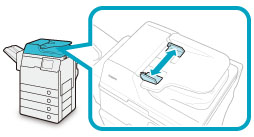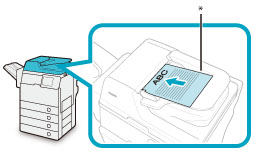 (Start). The machine automatically feeds the originals to the platen glass and scans them. Two-sided originals can also be automatically turned over and scanned as two-sided documents.
(Start). The machine automatically feeds the originals to the platen glass and scans them. Two-sided originals can also be automatically turned over and scanned as two-sided documents.Feeder
You should use the feeder when you want to copy several originals at the same time. Place the originals into the feeder and press  (Start). The machine automatically feeds the originals to the platen glass and scans them. Two-sided originals can also be automatically turned over and scanned as two-sided documents.
(Start). The machine automatically feeds the originals to the platen glass and scans them. Two-sided originals can also be automatically turned over and scanned as two-sided documents.
 (Start). The machine automatically feeds the originals to the platen glass and scans them. Two-sided originals can also be automatically turned over and scanned as two-sided documents.
(Start). The machine automatically feeds the originals to the platen glass and scans them. Two-sided originals can also be automatically turned over and scanned as two-sided documents.The following types of originals can be loaded in the feeder:
Weight:
One-sided scanning: 42 to 128 g/m2
Two-sided scanning: 50 to 128 g/m2
Original size: A4 and A5
Tray Capacity: 100 sheets of paper (80 g/m2)
|
IMPORTANT
|
|
Thin originals may become creased, if used in a high temperature or high humidity environment.
Do not place the following types of originals into the feeder:
Originals with tears, five or more binding holes, or cutouts
Severely curled originals or originals with sharp folds
Wrinkled originals
Stapled originals or originals with paper clips
Tabbed originals
Originals with adhesive tape or glue
Originals that are taped together
Carbon backed paper or other originals which may not feed smoothly
Transparencies and other highly transparent originals
Always smooth out any folds in your originals before placing them into the feeder.
|
1.
Adjust the slide guides to fit the size of your originals.

2.
Neatly place your originals with the side to be copied face up into the original supply tray.

* Original Supply Tray
If any dirt on the original scanning area is detected when the originals are placed in the feeder, the screen prompting you to clean the scanning area appears. Even though streaks may appear on the copies, you can continue to scan your documents by pressing [Close]. For instructions on cleaning the original scanning area, see "Manual Feeder Cleaning."
 CAUTION CAUTION |
|
Do not insert your hands in the gap in the original supply tray, as doing so may cause injury.
|
|
IMPORTANT
|
|
Do not drop clips or other objects into the gap in the original supply tray.
Do not add or remove originals while they are being scanned.
When scanning is complete, remove the originals from the original output area to avoid paper jams.
Do not place items in the original output area, as doing so may cause damage to your originals.
|
|
NOTE
|
|
The scanned originals are output to the original output area in the order they are fed into the feeder.
|
|
IMPORTANT
|
|
Limit repeated feeding to a maximum of 30 times (this number varies, depending on the type and quality of the original). If the same original is fed through the feeder repeatedly, the original may fold or become creased, and make feeding impossible.
If the feed rollers are dirty from scanning originals written in pencil, perform the feeder cleaning procedure. (See "Manual Feeder Cleaning.")
|